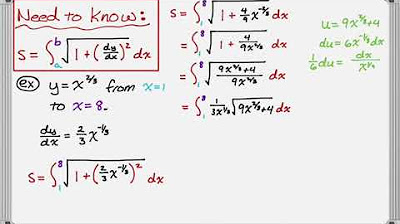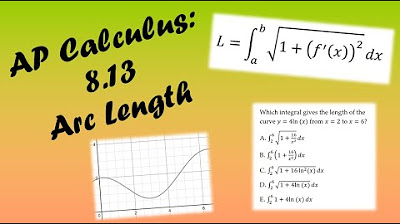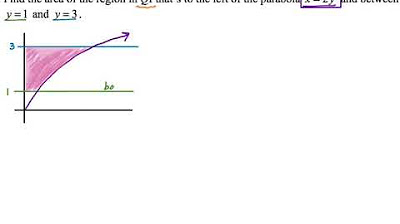Arc Length of y=x^(3/2) | MIT 18.01SC Single Variable Calculus, Fall 2010
TLDRIn this educational video, the presenter guides viewers through calculating the arc length of a curve defined by y = x^(3/2). The focus is on the curve segment between x = 0 and x = 4. The presenter explains the formula for arc length, ds, and how to apply it to the given function by finding dy/dx and integrating from the given bounds. A substitution method simplifies the integral, leading to a solvable expression. The video concludes with an approximate numerical estimation of the arc length, demonstrating the application of calculus to real-world problems.
Takeaways
- 📚 The video is focused on computing the arc length of a curve defined by the equation y = x^(3/2).
- 🔍 The curve is sketched and the segment of interest is between x = 0 and x = 4.
- 📈 The formula for arc length, ds, is derived from the Pythagorean theorem as √(dx^2 + dy^2).
- 📘 An alternative formula for ds is √(1 + (dy/dx)^2)dx, which is used for integration.
- 📝 The derivative of y with respect to x, dy/dx, is calculated as (3/2)√x.
- 🔑 The expression for ds is simplified to √(1 + (9/4)x^2)dx by substituting the derivative.
- 📉 The integral for the arc length is set up from 0 to 4 using the simplified expression for ds.
- 🔄 A substitution method is introduced with u = 1 + (9/4)x to simplify the integral.
- 📌 The new integral bounds are adjusted from 1 to 10 corresponding to the original x bounds.
- 📊 The integral is evaluated to find the arc length, resulting in a closed-form expression.
- 🔢 The final arc length is approximated numerically, with an estimate provided for the decimal value.
Q & A
What is the main topic of the video?
-The main topic of the video is computing the arc length of a curve given by the equation y = x^(3/2).
What is the range of x values for which the arc length of the curve is being calculated?
-The arc length is being calculated for the range of x values from 0 to 4.
What is the formula for the differential arc length ds in terms of dx and dy?
-The formula for the differential arc length ds is √(dx^2 + dy^2).
How can the formula for ds be rewritten in terms of dy/dx?
-The formula for ds can be rewritten as √(1 + (dy/dx)^2) dx.
What is the derivative of y with respect to x when y = x^(3/2)?
-The derivative of y with respect to x, denoted as dy/dx, is (3/2) * x^(1/2) or (3/2) * √x.
What substitution is made to simplify the integral for the arc length?
-The substitution made is u = 1 + (9/4)x, with du = (9/4)dx, and dx = (4/9)du.
What are the new bounds for the integral after the substitution?
-The new bounds for the integral are from u = 1 to u = 10.
What is the integral expression for the arc length after the substitution?
-The integral expression for the arc length after the substitution is ∫(4/9)√u du from 1 to 10.
How is the integral of √u evaluated?
-The integral of √u is evaluated as (2/3)u^(3/2), and after multiplying by the constant (4/9), it becomes (8/27)u^(3/2).
What is the final expression for the arc length after evaluating the integral?
-The final expression for the arc length is (8/27)[10^(3/2) - 1^(3/2)] which simplifies to (8/27)(10^(3/2) - 1).
How does the video suggest estimating the arc length without a calculator?
-The video suggests estimating the arc length by recognizing that √10 is slightly more than 3, and thus the result is likely a bit larger than 8.
Outlines
📚 Introduction to Arc Length Problem
The video script begins with an introduction to a problem-solving session focused on computing the arc length of a specific curve. The curve in question is defined by the equation y = x^(3/2), and the instructor provides a sketch to visualize its shape. The task is to calculate the arc length of the curve between x = 0 and x = 4. The audience is encouraged to pause the video and attempt the calculation before continuing. Upon returning, the instructor starts by explaining the concept of arc length and the formula for a small piece of arc length, ds, which is derived from the Pythagorean theorem and can be expressed as ds = sqrt(1 + (dy/dx)^2)dx. The function y in terms of x is then differentiated to find dy/dx, resulting in 3/2 * sqrt(x), which is substituted back into the arc length formula to prepare for integration.
🔍 Detailed Calculation of Arc Length
The second paragraph delves into the detailed calculation of the arc length. The instructor uses a substitution method to simplify the integral, setting u = 1 + (9/4)x, which leads to du = (9/4)dx and dx = (4/9)du. The bounds for u are also adjusted according to the original x bounds, resulting in an integral from u = 1 to u = 10. The integral simplifies to a form that can be easily computed by hand, and the instructor guides the audience through the integration process, resulting in an expression involving u to the power of 3/2. After evaluating the integral, the instructor provides a rough estimate of the arc length in decimal form and encourages the audience to use a calculator for a more precise value. The summary concludes by emphasizing the straightforward application of the formulas for arc length and the successful evaluation of the integral in closed form.
Mindmap
Keywords
💡Arc Length
💡Curve
💡Integral
💡Differential Arc Length
💡Derivative
💡Substitution
💡Bounds of Integration
💡Square Root
💡Polynomial
💡Numerical Method
Highlights
Introduction to computing the arc length of a curve defined by y = x^(3/2).
Sketch of the curve and focus on the segment between x = 0 and x = 4.
Recall the formula for arc length ds using the Pythagorean theorem analogy.
Alternative formula for ds involving dy/dx for integration purposes.
Derivation of dy/dx for the given curve y = x^(3/2).
Substitution of dy/dx into the arc length formula to find ds.
Integration of ds from x = 0 to x = 4 to find the arc length.
Use of substitution method to simplify the integral calculation.
Setting up the substitution with u = 1 + (9/4)x and du = (9/4)dx.
Adjusting the bounds of integration from x to u.
Simplified integral calculation using the substitution method.
Integration result expressed as a function of u.
Final calculation of the arc length using the evaluated integral.
Estimation of the arc length result without a calculator.
Discussion on the rarity of being able to compute arc lengths by hand.
Conclusion emphasizing the application of standard arc length formulas.
Transcripts
Browse More Related Video
5.0 / 5 (0 votes)
Thanks for rating:





